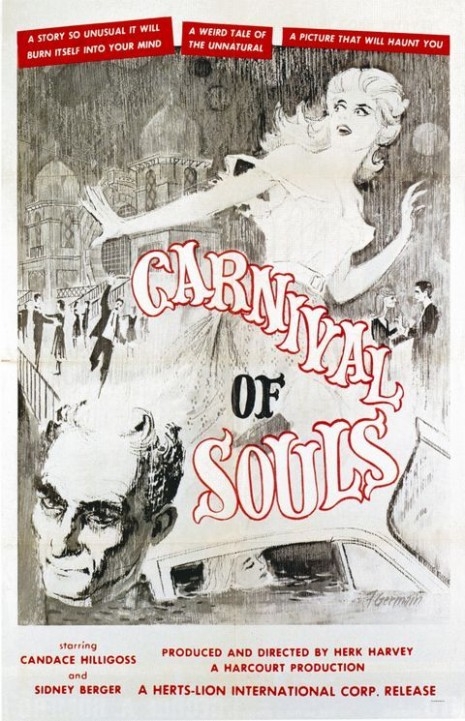
It reads like the synopsis for a Phil Alden Robinson movie: a middle-aged man, just divorced, travels through a city, where he chances upon a disused amusement park, which inspires him to make a film that will, one day, guarantee his success.
This is what happened to Herk Harvey, who happened on the Saltair Pavilion on the south shore of Salt Lake, when driving back from California, in the early 1960s. Herk worked as a director for Centron Films, America’s leading producers of industrial and educational movies, and he was inspired by Saltair’s eerie, haunted appearance. Harvey devised a scenario, and with help from colleagues at Centron, money form his girlfriend, a budget of $33,000, an unknown cast, and three weeks to film, he made The Carnival of Souls. It was a kismet moment, as Harvey returned to his work at Centron, the cast continued with their own lives, and the film’s star, Candace Hilligoss, only made one other film.
Saltair was the Coney island of the West, opened in 1893, a large structure with Moorish domes, leading on to a pier:
The girth of the resort rested on over 2,000 pylons, driven into the bed along the lakeshore. Many of the original posts can still be seen today, over a hundred years after the resort’s initial construction.
With many resorts of unseemly repute dotting the Salt Lake shoreline, the predominant Mormon population of the Salt Lake Valley called for a retreat that matched their conservative standards; the Great Saltair answered their call. Mormon couples could visit Saltair by taking a short train ride and dance the night away without becoming victims of indecorous rumors. This was due to the open and frequent supervision of activities at Saltair by prominent members of the Mormon Church. The Mormon Church, however, suffered some criticism for the sale of coffee and tea—both substances prohibited by church doctrine—and for opening the resort on Sundays.
Owners of Saltair enjoyed the popularity of the Western resort. From the beginning, the lake retreat was intended to be a counterpart to Coney Island. Its pylon bridge led thousands of patrons through its gigantic doors to countless days of lounging and swimming and countless nights of dancing and romance. Being one of the first amusement parks in America, it became the most popular family destination west of New York.
Fire damaged the resort twice in 1925 and again in 1931, this time causing $100,000 worth of damage. Like everywhere else in the 1930s, the Depression took its toll, as did the war, which led the venue to close in the 1950s, leaving its massive decaying structure, disused rail tracks, and rollercaoster. No wonder Herk Harvey was inspired:
This was the Saltair I knew firsthand… the Saltair of the schlock horror movie classic Carnival of Souls..rotting wood, broken glass, collapsed staircases… and always, the smell of the lake, the stganation of the swimming pool dredged years earlier, littered with half-submerged dodge-‘em cars.
Saltair lay deserted for years, but reopened as a music venue in 2005.
As for Herk Harvey’s The Carnival of Souls? Well, what was intended as a low-budget B-movie is now rightly considered a classic of gothic-horror cinema. So, next time you pass a location that gives you goose-bumped inspiration, just remember Harvey and imagine what you can do.